Thursday 10 January 2017
White: K. Nevols (134) - Black: R. Goodfellow (160)
The first game of the year. I had a good second half of 2016 and was on a run of six consecutive wins. My last twelve games had seen ten wins, two draws and no losses. But as you start a new year, new beginnings and all that, I had a fear my luck was going to change.
This was my first game for Rochester and, as I was told, we were 'with the big boys now'. So it was that my first opponent was a 160 grade - my highest graded opponent in a match since Game Three. I settled down for a tough contest.
1. e4 c5
2. Nc3
The Closed Sicilian makes another appearance.
2. .... e6
3. f4 a6
Unusual to play this so early but I wondered if my opponent was used to playing the Sicilian Najdorf which features this move.
4. Nf3 d6
Now 5. d4 cxd4 6. Nxd4 Nf6 would transpose into the Open Sicilian - the Najdorf variation with 6. f4. In this position White's most common moves have been 7. Qf3, 7. Be2, 7. Bd3 and 7. Be3. There's probably mountains of theory on this and a few books somewhere.
5. Be2
But I am not one for theory so will just stick to the usual developing plan.
5. ... Qc7
With the queen slightly dislodged there could be an argument now for transposing with 6. d4. If 6. .. cxd4 7. Nxd4 Nf6 8. Be3 White does not look too bad.
6. O-O Nbd7
7. Qe1 Ngf6
8. d3 b5
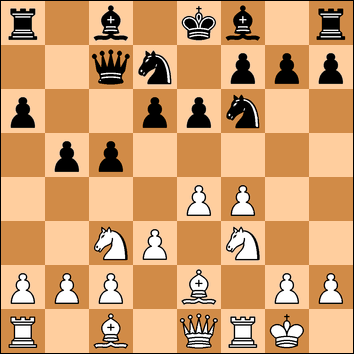
So Black sets out his plan. He is going to delay kingside development to attack and gain space on the queenside.
My thought process now went as follows.
1. Kasparov would probably think about 8. e5 here, sacrificing a pawn for some initiative.
2. I am not Kasparov.
3. However, I want to sacrifice a pawn - can I make it work?
4. 9. e5 dxe5 10. fxe5 Nxe5 11. Nxe5 Qxe5 and if 12. Bf4 then 12. ... Qd4+ - so that's nothing.
An alternative in this last line is 12. Bf3 Qxe1 13. Rxe1 Ra7 14. Bf4. Does White have enough for his pawn? He is threatening Bb8 Rd7; Bc6 or Bb8 Re7; Bc6+ Bd7; Bb7. The computer's recommendation after 14. Bf4 is for Black to play 14. .. b4 then 15. Nd5 Nxd5 16. Bxd5 a5 with Bb7 to follow.
Instead I decide to move the king so that there is no check for Black down the a7-g1 diagonal. In the system I play, I usually have to move it sooner or later anyway.
9. Kh1 Rb8?!
Now this surprised me. 9. .. b4 might have been better or even 9. .. Be7 although there might be some useful tactics to come with a later White Qg3.
The pawn sacrifice variation is now re-opened because the queen and rook are now on the same diagonal and Bf4 after the exchanges would skewer them both. I looked around for other moves but thought why not?
10. e5!? dxe5
11. fxe5
Now White has an advantage - if 11. .. Nxe5 then simply 12. Nxe5 Qxe5 13. Bf4.
One other line I looked at was 11. .. b4 then 12. exf6 bxc3 13. exg7 Bxg7 14. bxc3. White gets his pawn back and there are chances of a kingside offensive with Ng5.
Black however finds a good move.
11. .... Ng4
12. Ne4
12. Bf4 was probably better but I liked this move, hitting the d6 square and maybe heading for g5.
If now 12. ... Ngxe5 then 13. Nxe5 Nxe5 14. Bf4 looks strong. Black can't play 14. ... Bd6 because of 15. Nxd6 Qxd6 16. Qg3. Black could try 14. ... f6 15. Bh5+ Kd8 and I think White has got good play for his pawn.
12. ... Rb6
A sensible precaution moving off the diagonal and protecting the d6 square.
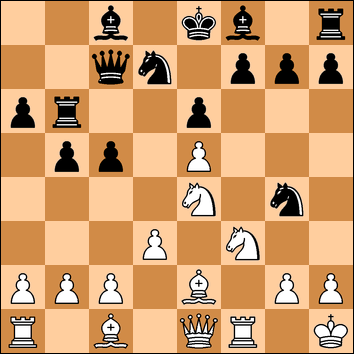
13. Bd2?!
This is a waste of a move. The bishop should have gone straight to f4. 14. Ba5 is not really a threat as the e3 square is then free for Black's knight. For example, 13. .... Bb7 14. Ba5 Ne3 15. Rf2 Nxc2. However if White finds 15. Qg3! Nxf1 16. Rxf1 then he keeps the advantage.
Black decides to play it safe and White finds the right move on the second occasion.
13. .... Qb8
14. Bf4 f6
White could now play 15. Nd6+ Bxd6 16. exd6 O-O 17. Nd2! Nge5 18. Ne4. But I did not want yet to simply the position and decided to develop the queen to keep the pressure on.
15. Qg3 Ngxe5
16. Nxe5 Nxe5
17. Bh5+ Kd8
So I am a pawn down but with a good attack as compensation. I was not sure in my ability to finish him off however. Black's defence has been good so far.
18. Rae1?!
After I played this move, I saw the Ng5 trick. Black is allowed one move which he uses to defend the g7 point.
18. ..... Qc7
19. Ng5!
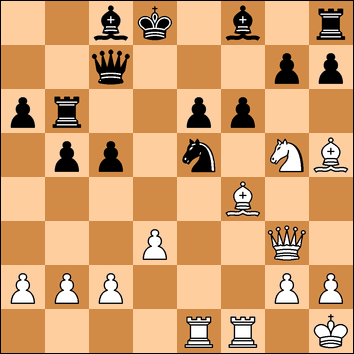
But I was really pleased to get this move in. The threats are pouring in now - all of White's pieces are attacking. The computer gives this position a White advantage of +1.5. Black now went into the tank for a big think and came up with the best defence.
19. .... Bd6!
20. Bxe5 fxg5!
I had not seen this move. Now White should play 21. Rf7! Bd7 22. Qxg5+ Kc8 23. Qxg7 and his position is overwhelming. The computer gives the line 23. ... Bxe5 24. Rxe5 Rd8 25. Qg5 h6 26. Qe3 c4 27. bxc4 dxc4 28. Rc5 Rc6 29. Rxc6 Qxc6.
But although White's position is very good - Black has defended very well and it is not easy to get the ball in the net.
21. Qxg5+ Qe7
22. Qxg7 Qxg7
23. Bxg7 Rg8
With the queens off, White's attack is much weaker and Black can try to move the bishops to attack the White king. I am a pawn up so my plan now is to round up the h-pawn and swap off pieces. With this in mind 24. Bf6+ would now be best forcing one exchange (24. .. Kc7 or 24. Kd7 then 25. Bf7).
24. Rf7 Bb7
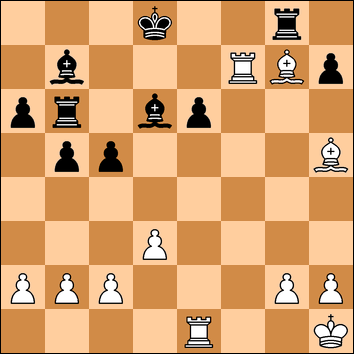
25. Bf6+?
White fails to adapt to the changed circumstances and begins to lose his way. Playing the bishop to g4 attacking e6 is best.
25. ... Kc8
26. Bf3 Bxf3
27. gxf3 Rf8
28. Rxf8 Bxf8
OK, so I am now a pawn up. I thought I must have at least a draw here.
29. Rg1 Kd7
30. Rg8 Ke8
31. Bg7 Kf7
32. Rxf8+ Kxg7
And now the bishops are gone.
33. Rc8 c4
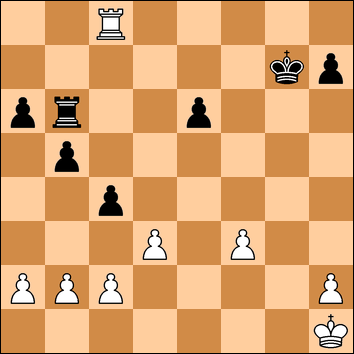
Now I was thinking of cashing out with 34. dxc4 bxc4 35. Rxc4 Rxb2 36. a4 and a draw offer. I had an extra pawn and all the pawns are isolated, and Black, considering he had been under pressure for most of the game, might have taken it with relief.
Instead I still try to win - and pride comes before ....
34. d4 Rd6
35. c3 e5!
Brilliant. Black temporarily sacs a pawn to allow the Rook to cause some mischief.
36. dxe5 Rd1+
37. Kg2 Rd2+
38. Kg3 Rxb2
Now White should play 39. a4. If he can take both Black's queenside pawns he will have a draw in hand. Instead I play a disastrous sequence allowing his King to advance.
39. Rc7+ Kg6
40. Rc6+ Kf5
41. f4?
Why not 41. Rxa6 Kxe5 42. Rb6? The answer is that I am still thinking of winning the game.
41. ..... Rc2
42. Rf6+ Ke4
43. Rxa6
At last - the problem is that all those wasted rook moves have resulted in the Black king and rook both being far better placed.
43. .... Rxc3+
44. Kg4 Rc2
45. e6 Rg2+
46. Kh3 Rg7
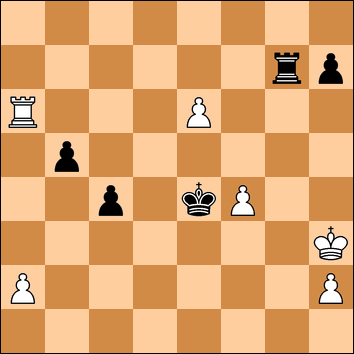
Now 47. Rb6 and it will soon be time to shake hands.
47. f5? Kxf5
48. Ra5 Kxe6
49. Rxb5 Rc7!
50. Rb2 c3
Now it is all over - Black's king can just advance to shepherd the pawn home.
51. Rc2 Kd5
52. Rg2 c2
53. Rg5+ Ke6
And I now resigned. Perhaps one of the worst rook endings I have ever played. Black deserves great credit for the defence in the middle game and the way he managed to turn the tables. He told me afterwards that 19. Ng5! was a move he had not seen at all but still managed to find the right defence. Nevertheless the lesson here is to know when to cash out for a draw or, as the song goes, know when to hold them and know when to fold them.
Rochester v Tunbridge Wells
Keith Hyde (167) 1/2-1/2 Robert Jacobs (172)
Trefor Owens (167) 1/2-1/2 Jerry Anstead (165)
Chris Marshall (143) 1/2-1/2 C Lucjan Karpinski (163)
Keith Nevols (134) 0-1 Russell Goodfellow (160)
Jerry Pol (124) 0-1 Hugh Tassell (147)
Tyrone Jefferies (116) 1/2-1/2 James Robertson (106)
Rochester 2-4 Tunbridge Wells
No comments:
Post a Comment